The HobbitHouse Ilustrated Glossary of Woodworking terms
A
B
C
DE
F
GH
IJK
L
M
NO
P
QR
S
T
UVWXYZ
To see general comments about this glossary and for the email address, click here: GLOSSARY
for images of wood itself, go here: wood id site

lacquer --- A type of varnish, that has many different formulations with some variations in characteristics, and is quite a complex topic which I am not going to delve into in detail in this first cut at this glossary. Basically it is a set of chemicals dissolved in a (usually) quick-evaporating base that is applied in many thin layers, each of which dries quickly, and all of which taken together provide a hard durable finish that can be applied in, or worked to, any level of gloss from low matte to high gloss. It cures (quickly) by evaporation of the solvents, is more durable than shellac, and is waterproof and resistant to chemical stain (but you should still use coasters, just like your mother taught you to!). Compare/contrast to other finishing agents.
lacquer thinner --- A blend of solvents used to reduce the viscosity of lacquer and/or to eliminate blushing
ladyfinger gouge --- synonymous with spindle gouge
lag bolt --- A commonly used (but technically incorrect) alternate name for what is more often, and more correctly, called a lag screw. This fastener does NOT take a nut so it's screw, not a bolt. (see bolts vs screws).
lag pintle --- A particular type of pintle which is just an L-shaped cylinder with threads on one end and a short barrel-stop below the pin. It is attached by just screwing it in. Widely used in mounting to a round gate post where the normal strap-type pintle and the plate pintle don't fit well. Examples:
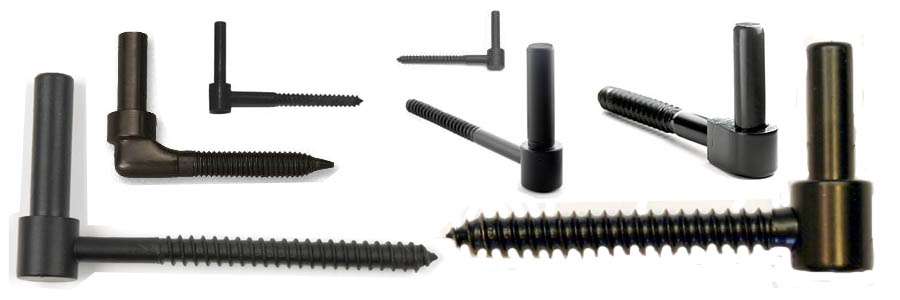
lag screw --- A screw with a hexagonal head so that it can be turned with a wrench instead of a screwdriver, thus allowing more torque. Typically used for heavy-duty joints such as screwing a couple of two-by-fours together or screwing a load-bearing metal plate onto timber, but also used with a lag screw shield to screw things into masonry. Due to the need for strength these are pretty much always made of steel. They come in a wide variety of diameters and lengths. They are also called, technically incorrectly, and less commonly, "lag bolts" because of the straight shank and the head that is more commonly seen on a bolt than a screw; they have wood-screw type threads and are not designed to screw into a nut. See bolt vs screw. Example:
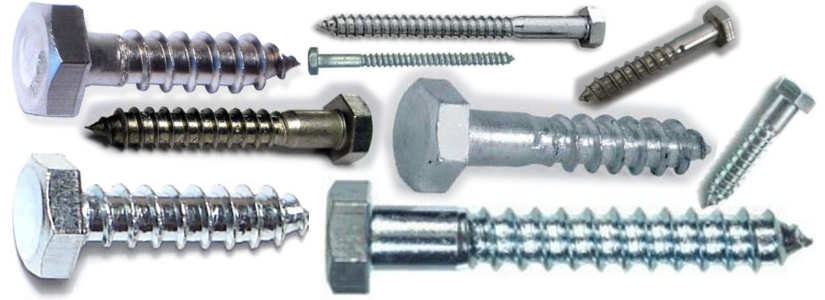
lag screw shield --- A lead sleeve that is put into masonry so that a lag screw can be used to attach something to it. Operation is similar to that of an expansion anchor bolt. Examples:
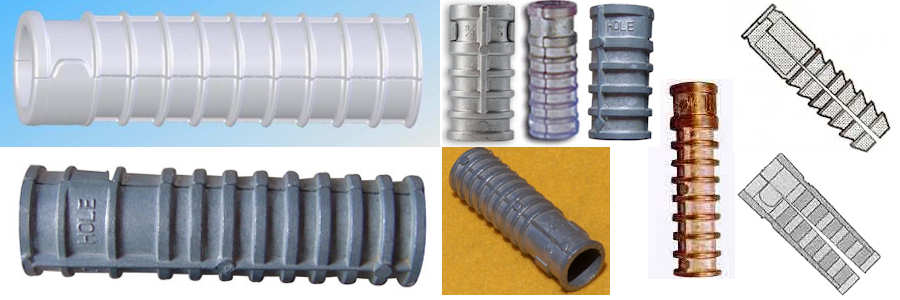
lally column --- A very strong support post, usually consisting of a steel pipe filled with concrete, that supports beams or girders that in turn carry much of the weight of a structure.
laminate --- [noun] A thin sheet of synthetic material such as Formica that is put down over a substrate. This is a normal construction technique for kitchen counters, for example, where the chosen laminate will be totally waterproof and also resistant to damage by heat and the common chemicals associated with food preparation. Also laminates can usually be cleaned easily and repeatedly without fear of exposing a surface (such as wood grain) that might easily accumulate bacteria.
laminate --- [verb] The process of bonding together two layers (laminations) of material with adhesive and possibly heat and/or pressure. More broadly it is sometimes used to describe bonding together materials that are not in panel form.
laminated --- Built up in layers. Glulam is one example of a laminated object.
laminated strand lumber --- [LSL] An engineered wood product in which wood strands are separated out, aligned all in the same direction, and then dried, coated with resin and pressed under high temperature into forms that are suitable for cutting up to make support members. LSL is relatively strong and can be made from low grade logs that would not otherwise be usable for construction material.
laminated timber --- see parallel strand lumber
laminated veneer lumber --- Structuralgrade timber veneers glued together under pressure to form a dimensionally stable and uniform product. An engineered (man-made) wood product that is a substitute for dimension lumber. LVL is glued such that the grain direction of all veneers is parallel; this is different than plywood in which the grain directions of adjacent veneers is perpendicular to one another, but it is very similar to parallel strand lumber. LVL and other composite materials have a number of advantages over solid lumber, including the ability to make large-sized members from small diameter trees. Such products also allow the dispersion of gross defects such as large knots.
laminate veneer --- usually synonymous with phenolic veneer
lamination --- A material or object that is built up in layers. glulam is an example of a material created by lamination.
laminboard --- A man-made building board with a core of narrow strips of wood glued together along their wide faces and sandwiched between thin plywood sheets. The name is a contraction of "laminated board".

landing --- (1) An intermediate platform in a staircase, part way between two floors of a building; a wide area half way up a two-part staircase.
landing --- (2) A cleared area within a timber harvesting operation where harvested logs are processed, piled, and loaded for transport to a sawmill or other facility.
lap --- (1)[noun] See lap joint
lap --- (2)[noun] The area where sections of roll roofing or rolled underlayments overlap one another when the material is being put into place.
lap --- (3)[verb] To position adjacent objects so that one surface extends over the other. Term may designate a lap-siding technique for roof shingles or siding shingles or other house siding, in which each panel or piece overlaps the edge of the next lower one. Also, the creation of a lap joint
lap joint --- A joint made by cutting of part of the face off of one or both of two planks and then placing one over the other so that the faces are flush with each other and then bonding the overlapped portions. This can be at the ends or in the middle, and there are specific names for the particular forms. Also called "shiplap" joint. When one of the mating pieces is only as thick as the groove in the other piece, the joint is a "full lap" joint and when the two planks are the same thickness and half is cut out of each one, it is a "half lap" joint (there are a couple of exceptions to these general rules). There are a huge number of variations on this joint, most of which are fully explicated in this glossary under the following set of terms for full lap and half lap joints:
lap marks --- (1) Marks left when a coat of finishing agent extends over an adjacent coat that has been allowed to dry too long so that the two coats do not blend and the edge of the 2nd coat just sits on top of the 1st coat.
lap marks --- (2) Refers to marks left from a brush or other applicator when a finishing agent is not applied evenly, or sometimes when climate conditions are not ideal.
lapped dovetail scarf --- A lap scarf joint in which the lapped portions are shaped as a dovetail joint. There is another version that I think is a better joint, albeit somewhat more complex to create, and that is the shouldered lapped dovetail scarf. Examples:
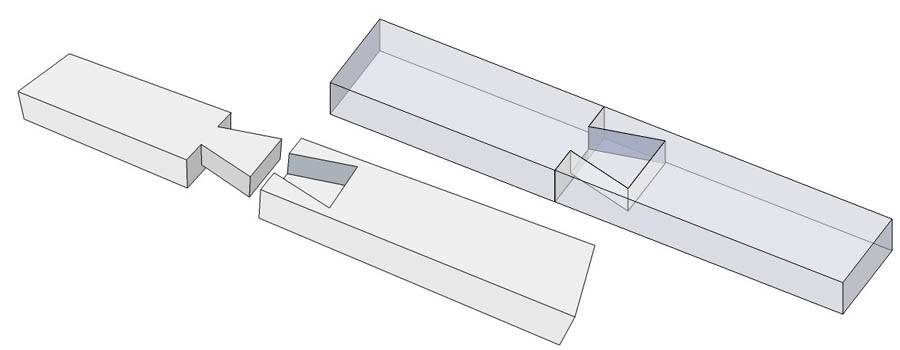
lapped dovetail splice --- I have seen this name used for both the lapped dovetail scarf and the shouldered lapped dovetail scarf.
lap scarf --- A scarf joint with a simple lap in the ends of the mating planks rather than the angled cut of the "standard" scarf joint. Examples:

large knot --- A knot larger than 1 1/2-inch in diameter. This definition is often seen, but I'm not aware of any governing body that has, or even can, dictate this definition as absolute. See knot sizes for comparison with other knot size "definitions".
latch jamb --- synonymous with strike jamb
late growth --- That portion of tree growth that occurs late in the growing season (summer and early fall) and is also called "summer wood" or "summerwood" but that term is deprecated because early and late growth in tropical zones are more the result of rainy seasons than a non-existent summer/winter cycle. Such wood tends to be more dense, stronger, and darker in color than the early growth.
lateral --- Sideways or to the side of; in framing this means horizontal vs vertical. Wind is a lateral force whereas gravity is a vertical force. Compare/contrast to vertical.
lateral bracing --- Bracing against lateral force. In framed structures such as houses, this takes the form of sheathing (usually plywood) that is nailed to the framing specifically to provide lateral support.
lateral force --- A force that acts sideways (in framed structures, this means horizontal vs vertical). framed structures require bracing against lateral force (see lateral bracing in additional to bracing against the vertical forces caused by gravity. Lateral forces include wind and earthquakes.
late wood --- synonymous with late growth
lath --- Back before drywall came into being, the walls of houses were finished by nailing thin strips of wood (laths) horizontally across the vertical support beams and then slathering on plaster. Many older homes (mine included) still exist with that kind of wall construction. It's a real pain to deal with sometimes, because it is not very uniform in thickness and the laths tend to be springy, so putting in molly bolts, for example, to hang paintings with, can be a real challenge. Also, plaster and lath walls tend to develop cracks in the plaster more often than happens with drywall. Laths are usually attached to the studs with lath nails which are extra-skinny so as to avoid splitting the lath strips. Examples (these all show the BACK side of plaster and lath walls):
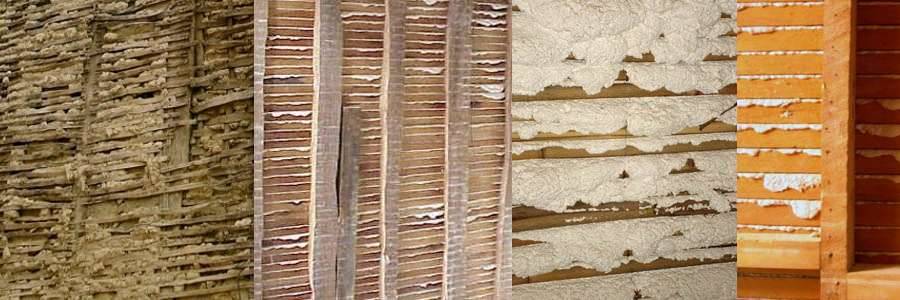
lathart --- A type of folkart that uses lath from old plaster and lath walls. Examples:

lathe --- see wood lathe (there are metal lathes too, but this is, after all, a glossary about wood, not metal).
lathe box --- This is a rarely used term that distinguishes round "boxes" from rectangular boxes. In normal English, "box" carries a connotation of "rectangular" whereas in wood turning, it does not, since round "boxes" turned on a lathe are just called boxes (which is why I say that the term "lathe box" is rare). Anyway, a lathe turned box is a turned container with upper and lower sections. The parts often have their outer surfaces turned first as a single unit, then they are separated (parted) using a parting tool and their insides are hollowed out separately on the lathe with the rims turned in a way to make the upper part be a form-fitting top to the lower part. Lathe boxes tend to have sides that are straight up and down as opposed to the more curved form of other type of lathe turnings. Compare/contrast to other lathe turnings. Examples:

lathe center --- Any of several devices that are used to support and/or drive work in or from the headstock or tailstock of a wood lathe. There are a couple of primariy characterists of lathe centers. First, they are either drive centers, which help transfer the motor power to the workpiece to make it turn, or support centers, which act only as a support for the workpiece. Drive centers go in the headstock and support centers go in the tailstock. Second, tailstock support centers may be "live" or "dead". live centers have ball bearings and turn with the workpiece whereas dead centers are locked in place and do not turn with the workpiece. The various types are:
- headstock drive centers
- tailstock support centers
lathe check --- The condition of the underside of veneer sheets as they come off of a veneer lathe. This is described in some detail with the term loose.
lathe chisel --- A chisel used in turning on a wood lathe. In colloquial use, the term includes tools that are technically lathe gouges and includes most of the tools shown in this glossary that are listed with the term lathetools. Lathe chisels tend to have longer handles than other chisels because they have to provide leverage against the force of the turning wood into which they are inserted.
lathe chuck --- see chuck
lathe gouge --- A lathe tool; a sharp, curved edge cutting tool with a an oval or cylindrical barrel. The barrel has a 'U' shaped portion (sometimes a "V" shaped portion) called the cannel, or the flute, removed from its upper section, sometimes all along the length, sometimes only along the first few inches back from the cutting tip. The edge is sharpened and honed and the gouge is used with the resulting sharp bevel cutting into the surface of wood revolving on a lathe. There are three main types of lathe gouges. (1) The roughing gouge, which is used, as the name suggests, to rapidly remove large portions of wood. (2) The spindle gouge, also called a "shallow fluted gouge", which is used primarily to do spindle turnings. (3) The bowl gouge, also called a "deep fluted gouge", which is used for face turnings.
Despite those designations for "typical" use, bowl gouges can be used for spindle turning and spindle gouges can be used on face turning, although in both cases this is often not a good idea. The lengths of lathe gouges vary quite a bit, from as little as 6 or 8 inches for turning very small objects on a mini-lathe, up to 2 feet long, or even more, for doing large turnings. The long handles are to provide leverage so that the turning wood doesn't grab the end of the gouge and jerk it out of the operator's hand, and the bigger the turning, the longer the handle needs to be to provide good leverage. The distance from the toolrest to the workpiece is also a large factor in the leverage. Bowl gouges tend to be longer and heavier than spindle gouges and they have a deeper flute/cannel. See also lathe scraper, carving gouge, and lathe gouge shape comparison
lathe scraper --- A lathe tool; a flat piece of steel with a rectangular cross section . There is a handle on one end and a flat or curved edge on the other end that is beveled and ground to a cutting edge. The cutting edge is used in a scraping action when working on a turning in a wood lathe. There are several different types of lathe scrapers, all of which are pointed to in the term lathe tools, but the two primary types are the round nosed scraper and the flat nosed scraper.
lathe steady --- synonymous with spindle steady
lathe tools --- This is a bit of a misnomer, albeit a widely used one. "Lathe tools", to be completely correct, would include tool rests, chucks, gouges, chisels and possibly some other tools, but the term is actually used fairly widely to refer just to the CUTTING tools used with lathe turning, and that's how I use it here. Those cutting tools include occasional specialty tools other than those listed below, but this list covers all normal lathe tools and the terms associated with them, and each points to a separate definition, most with illustrations. I have also included some terms that are not tools (e.g. fingernail grind) but which help explain the tools and their uses
lathe turning --- [verb phrase] To use a lathe to turn an object, via either spindle turning or face turning using a lathe tool.
lathe turning --- [noun] An item turned on a lathe. There are numerous shapes, and there is no central authority to provide exact definitions of the terms used to describe them, and turners are a clever crew, always creating variations that defy strict definition, but I think most turners would pretty much agree with the following more or less, maybe, sort of, with caveats, if they are not in a cantankerous mood. Also, please note that for some of these, the term as used by woodworkers may not correspond exactly to the sense that the word has in normal English usage; I am only concerned with how the terms are used by woodworkers.
Below this set of definitions is a composite drawing showing a single sample shape of each many of the forms. The terms themselves are linked to a more extensive definition where there are generally composite pics of numerous examples of the corresponding form.
- bowl --- Generally, the height is less than the diameter (but it could be a little more) and the rim is the largest diameter. If the rim curves back in towards the center, the object is more likely to be called an "open form" and if it curves back to a very small opening, the object is a "hollow form". The range of shapes that are called bowls is QUITE large and the difference between "bowl" and "vase" is sometimes debatable.
- box --- A more-or-less "pot"-shaped turning that has a lid which fits fairly snugly, often VERY snugly. Typically, "boxes" are fairly small in diameter (over 6 to 8 inches would be rare) but there is nothing in the definition that requires them to be, although bigger ones tend to be called "lidded vessels", as do ones that differ significantly from the "pot" shape. "Boxes" are sometimes turned with wings in which case they are often more curved than normal "boxes" (see "winged box").
- chalice --- A goblet or pedestal bowl intended to hold a drink. I don't list/show this separately in this glossary because I rarely see it used with wooden objects and I feel that it is something of an affectation when it IS used since "chalice" more normally designates an ornately decorated metal object.
- dish --- This is not a term I have often encountered in wood turning. It seems to be a shallow "bowl" or a deep "platter", where the height is less than half the diameter and the whole thing is modest in diameter (if the diameter is large, it's more likely to be called a "platter"), but I have seen this so seldom that I'm not including it as a separate term outside this list.
- enclosed form --- A term that is synonymous with "open form", as weird as that sounds. I think the use is taken from the point of view of a bowl, from which point of view the item looks relatively closed, rather than from the point of view of a "hollow form" from which point of view it looks relatively open.
- goblet --- A somewhat vague term, which I have seen used to describe turned objects that have the shape of anything from a wine glass (sides pretty much straight up after curving away from the stem) to what I think of as a goblet shape, which is more like a cognac snifter.
- hollow form --- Has an opening that is significantly less than the maximum diameter. Generally the side will curve out and then back in, not be straight up and down. If the opening is fairly large, the object is more likely to be called an "open form". The difference between "hollow form" and "vase" is often non-existent and the decision on which term to use can be arbitrary
- knuckle buster --- This is a humorous reference to the fact that when turning items with deep wings (see "winged bowl" and "winged box") the wings act like propellers and the careless turner, who will not find it even REMOTELY amusing, can get the dickens smacked out of his/her fingers/knuckles.
- lidded bowl --- Sometimes synonymous with "box", but if the object is quite oval and has a lid, then many turners will call it a "lidded bowl" instead.
- lidded vessel --- Generally, an "open form" (but it could be a "vase" shaped turning) but with a lid. Lidded vessels tend to be bigger than "boxes" and have more curve in the sides and the lid usually is slightly loose as opposed to the close-fitting lid of a "box". A tall, relatively slim "lidded vessel" is likely to be called an "urn", especially if it has a pedestal or foot on the bottom. NOTE: many turners do not designate much of ANYTHING as a "lidded vessel", preferring to call the item whatever it would be called without the lid. Thus an "open form" with a lid is often just called an "open form", not a "lidded vessel".
- natural edge --- A turned item, most often a "bowl" or a "vase", that still has the bark from the tree on its rim or at least has the raw area where the bark used to be.
- open form --- The opening is larger than the base but significantly smaller than the maximum diameter. If the opening is really small, it's a "hollow form" and whatEVER the size of the opening, it might well be called a "vase" depending on which side of the bed the turner got out on that morning.
- open segmented bowl --- A "segmented bowl" that has empty spaces among the pieces.
- pedestal bowl --- A "bowl" that sits on top of a shorter turning designated a "pedestal". The pedestal COULD be turned from the same integral piece of wood, but often is turned from a different wood glued to the upper "bowl" portion.
- platter --- A very shallow, flat "bowl", with a diameter significantly larger than the height. Anything more than a couple of inches high is not likely to be called a "platter" and even that is high unless the turning is a couple of feet in diameter.
- pot --- The height and diameter are approximately the same, opening is pretty much equal to the diameter, sides are straight up. Like a standard kitchen cooking pot, this item is pretty much square in cross section, but unlike a cooking pot, it has no lid (if it had a lid, it would be called a "box".
- segmented bowl --- A "bowl" (and actually some of the other forms listed here are also done in segmented form) that is made up of glued-up piece of wood that are usually from at least a few different species and arranged in a geometric pattern. If there are empty spaces among the pieces, it is an "open segmented bowl".
- spindle --- long and skinny and not hollow (a table leg is a "spindle")
- urn --- A turning that is "vase"-like in proportion but with a smaller opening, like a "hollow form", and with a snug lid. The distinction between "urn" and "lidded vessel" is sometimes debatable. "Urns" typically have a "pedestal" or "foot" at the bottom. Like normal English usage, "urn" MAY mean a cylindrical container that holds cremated ashes.
- vase --- The height is more than the maximum diameter (often quite a bit more) and the opening is anything from the maximum diameter to a little less than the maximum diameter. If the opening is significantly less than the maximum diameter, it's usually called a "hollow form" but usage of these terms varies considerably. A slim vase with a top would be an "urn". The difference between "bowl" and "vase" is sometimes debatable and the difference between "urn" and "vase" is not debatable only because an "urn" has a lid and a vase doesn't.
- vessel --- A term that is used for damned near anything in this list; too vague for me to try to pin it down any further.
- winged bowl --- there are two types of bowls that are called "winged". The first is a bowl with "wings" that flow from the upper rim back downwards. Such drooping drooping wings may stop short of the bottom of the bowl or they may go down so far that the bowl is supported by the tips of the wings rather than the bottom of the cavity part of the bowl and when this is the case, the bowl is called a "lifted bowl"? or "raised bowl"? (or something like that --- I need some help here.). The second type is a bowl with a flat portion extending out from the top, or near the top, of the bowl. This is often done with burls. "winged bowls" are sometimes tuned in a way that allows them to be given tops, in which case they are called "winged boxes".
- winged box --- A "box" with "wings" that flow from the upper rim back downwards, or sometimes straight out. Downward drooping wings may stop short of the bottom of the box or they may go down so far that the box is supported by the tips of the wings rather than the bottom of the cavity part of the box and when this is the case, the box is called a "lifted bowl"? or "raised bowl"? or something like that and the "box" is often turned with an underside that is more round that would be the case on a normal "box".
RELATED TERMS:
- art --- A turned item with a high price.
- craft --- A turned item with a medium price.
- junk --- A partially turned item currently in flight across the shop ("Uh, Houston, we have a problem!")
SAMPLE FORMS (intended to be at least vaguely representative of the various shapes):

lath nail --- A slender nail that is used to attach lath to studs. It is skinny so as to avoid splitting the lath strips. Sometimes particularly short lath nails will have ridges along the shank to enhance holding power. I note that although the definition, and common sense, say that the lath nail is and should be slender, some nails sold as lath nails are NOT particularly slender. Examples:
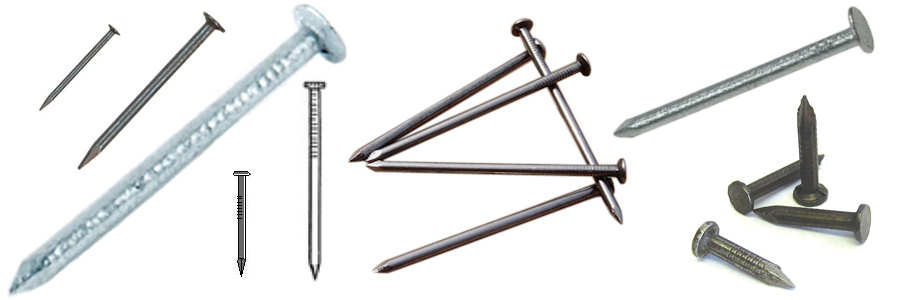
layer --- In any laminated construction such as plywood the sheets that make up the construction are also called "layers".
layup --- The step in the manufacture of composite material into panels in which the layers are stacked together ready for gluing and pressing.
L bolt --- A rod threaded on one end and then bent into an "L" shape. The purpose of an L bolt is to be embedded in concrete with the threaded part extending up out of the concrete and thus, like it's cousin the J bolt it is sometimes called a "cast in place" bolt. Examples:
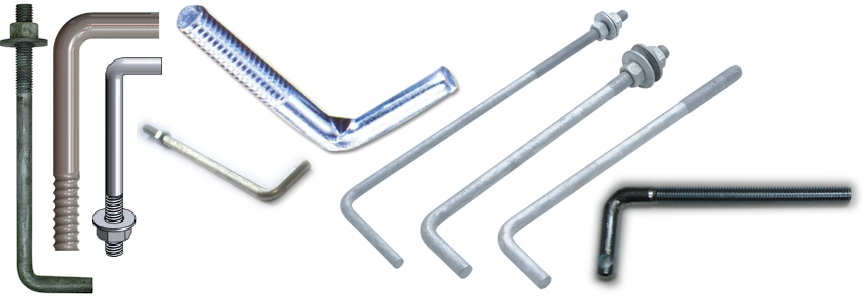
lead --- (1) The tendency for planks that are being rip cut to direct the saw parallel to the wood grain. This can be a particular problem when ripping quartersawn hardwoods with a thin bandsaw blade.
lead --- (2) In logging, this is the established direction in which all trees in a quarter or strip are to be felled and it is usually governed by the terrain of the area, or its general slope or skid road system.
leading edge --- the leading part of a cutting surface as it moves into the wood being cut.
lead screw --- A device that uses a threaded rod with a mechanism riding on it to translate rotational motion to linear motion. A very common woodworking application is in a bench vise which uses a large lead screw to translate the rotational movement of the turning rod to the in/out motion of the vise jaws. Lead screws do not work as well if the thread profile is triangular as on a bolt as they do if the threads are more rectangular in cross section. Even with rectangular cross section threads and a heavy coating of grease, lead screws are not designed for continuous, powered motion because of the friction inherent in their design. A similar device with less friction, but more costly manufacturing, is the ball screw.
leaf --- (1) [plural "leaves"] An organ of a tree (or other plant) typically divided into a flattened portion (the blade) and a narrow stalk (the petiole) and serving as the principal site of photosynthesis in the plant.
leaf --- (2) An extra section that is inserted into a table to extend its surface area. There is a version (drop leaf) that is not removed, but that drops down to the side of the table when not in use.
leaf --- (3) see hinge leaf
leaf width --- In a hinge, this is the distance from the center of the (hinge) barrel to the outer edge of a (hinge) leaf. See hinge dimensions.
lean --- A logging term referring to the directional tilt of a tree away from vertical. There are two lean forces that may be in play in the same tree. They are referred to as head lean (the greater of the two) and side lean (the lesser of the two). The lean, or leans, of a tree can be easily established with the use of a plumb bob or axe handle.
lean-to dormer --- synonymous with shed dormer
leather punch --- A steel rod with a hole up the middle of the bottom and a sharpened rim on the bottom, used for punching holes in leather. There is usually an area removed from the lower side of the tool so that the little circles of leather don't jam up inside the barrel. There is another kind of leather punch which is a series of small hole-punch cylinders mounted around a rim that can be rotated to put any given cylinder in place to punch against a pad via the force from a squeeze-handle. I show one of those on the right side of the composite image below, but this is strictly a leather working tool whereas the version that I am talking about with this term is the type more likely to be found in a woodworking shop because it has other uses as well, such as punching out holes in veneer. Examples:

ledger --- see ledger board
ledger board --- (also, just "ledger") A horizontal framing member that is put in place to support other framing members such as joists and rafters. Normally the other horizontal members are butted up to the ledger board and attached with a hanger, but there is nothing in the definition that requires that, and sometimes a ledger board will be completely UNDER the other horizontal members (as it is in one of the examples below), in which case it is often called a "ledger strip". You may also see BOTH a ledger board AND a ledger strip in use at the same time. When that is done, the butted up members may be toenailed to the larger ledger board and supported underneath by the ledger strip. Examples:
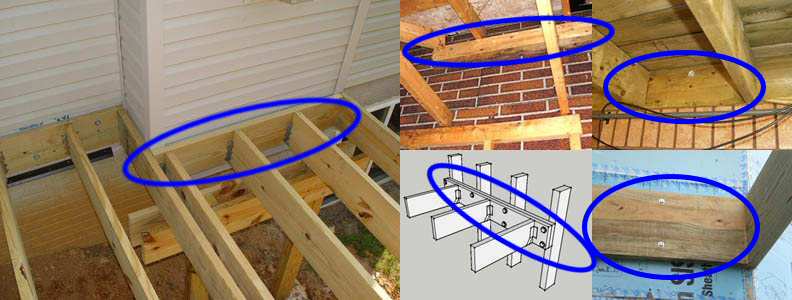
ledger strip --- see ledger board
left tilt --- Table saw blades need to be able to tilt in order to do miter cuts and depending on the type of saw, this has various ramifications. There are theological debates regarding left tilt vs right tilt, with a mild consensus that the left tilt is "better" (for a couple of non-overwhelming reasons) and a stronger consensus that if you are accustomed to one or the other and buy a new saw you are better off sticking with what you are used to. The main arguments in favor of a left tilt are that (2) the standard configuration on table saws is for the rip fence to be on the right of the blade (tilt doesn't really matter in crosscutting) and a right-tilt blade can trap the cut-off strip between the blade and the fence and cause dangerous kickback, and (2) when cutting a full edge bevel along both edges of a plank, a right-tilt blade used with the rip fence on the right causes the second cut to be made with the skinny edge of the first bevel at the bottom of the fence, which can cause jams. The main reason those arguments are not very strong is that on most saws you can move the rip fence to the left side of a right-tilt blade and have the same advantages as with the more common configuration of using the rip fence on the right side of a left-tilt blade. Other arguments have to do with the placement of the motor on contractor saws where a left tilt requires the motor to be on the left side of the blade (this reverses the direction of the tightening nut, among other things). There are some other considerations, and there are extensive discussions of this issue on the internet but I have covered the main considerations.
length stop --- see stop block
level --- [verb] To cause something to move to the horizontal plane.
level --- [adj] Horizontal
level --- [adj] Describes position (eye level, ground level, sea level, etc.)
level --- [adj] In woodworking, this word is used in its sense of "even with" or "flush with"; used to describe a situation where a portion of an object, or an adjoining object, is level with the main object. Compare/contrast to shy (below) and proud (above). Synonymous with flush.
level --- [noun] Amount or degree (as in "a level of precision")
level --- [noun] synonymous with spirit level
leveling --- (1) The act of applying a coat of a finishing agent so as to smooth out a previously rough coat.
leveling --- (2) The act of using a level to assure that a surface is perpendicular to gravitational vertical.
leveling agent --- Additive which is able to reduce the surface tension of a finishing agent to obtain better wetting and leveling effect, and to improve the surface flow of a finishing agent. Poor surface flow can induce coating defects such as orange-peel, craters, brush marks, etc.
lever --- One of the 6 simple machines on which many woodworking tools are based, this is a strong moveable object, such as a steel bar, that is used in conjunction with a fixed object (the fulcrum or pivot point) to multiply mechanical force. Think of a see-saw. If you put a 200lb man on a seesaw right up next to the fulcrum and put a 50lb child on an end 10 feet away from the fulcrum, the child will cause the man to go up, although by much less than the child goes down. This trade-off between the size of the force and the size of the movement is called the mechanical advantage and is a fundamental concept in classical mechanics. The most brute-force use of the lever in woodworking is the crowbar.
leverage --- Technically this is the amount of mechanical advantage provided by a lever but more colloqually it refers to the mechanical advantage provided by any simple machine. For example, it would be a lot more normal to say that a ramp up a loading dock (technically an inclined plane) gives you leverage than it would be to say that it gives you "mechanical advantage".
LF --- Linear Foot
L flashing --- Long strips of flashing used at horizontal wall joints, bent to resemble an "L". See also Z flashing.
Lhook --- A small metal rod, threaded on one end and bent into an "L" shape on the unthreaded portion, and it may or may not have a circular flange separating the two sections. The device is screwed into a wall or other holding element so that things can be hung from it. Examples:

lidded bowl --- Sometimes synonymous with box, but if the object is quite oval and has a lid, then many turners will call it a "lidded bowl" instead. Compare/contrast to other lathe turnings.
lidded vessel --- In wood turning, this generally refers to an open form (but it could be a vase-shaped turning) but with a lid. Lidded vessels tend to be bigger than boxes and have more curve in the sides and the lid usually is slightly loose as opposed to the close-fitting lid of a "box". A tall, relatively slim "lidded vessel" is likely to be called an urn. Compare/contrast to other lathe turnings. Examples:

lift --- the tearing of wood grain when a cutting edge such as a chisel is pushed against the grain and is thus unable to perform a clean cutting action but instead performs a lifting and/or crushing action prior to the cutting action or in instead of the cutting action. In the drawing below, cut A is creating lift and cut B shows the correct chisel-blade alignment to cause cutting, not lift.

lift off hinge --- A type of hinge that allows the hinged item (such as a cabinet door) to be lifted off of the fixed item (such as the cabinet) just by lifting it up and without the need for any tools. These may or may not be a type of cam lift hinge and if the end of the barrel opposite the one through which the pin protrudes/enters is totally closed, these may be sold under the designation barrel hinge (type 2). Other types of hinges that can be liftoff types (but will not necessarily be) include the HL hinge, the olive knuckle hinge" and others. Examples:
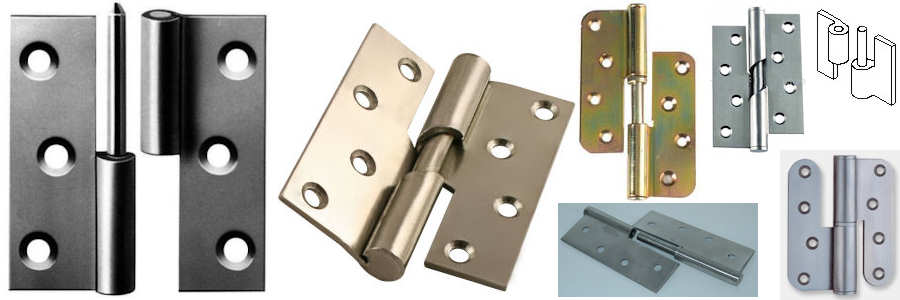
lightfast --- A finishing agent which is does not significantly fade on extended exposure to direct sunlight.
light induced color change --- The change in wood color caused by exposure to UV light. Some woods (e.g. padauk) darken, some (e.g. redheart) lighten
ligneous --- Consisting of or containing lignin or xylem. More loosely, "Of wood" or "resembling wood", "woody". Examples of ligneous materials other than wood are bagasse, bamboo, cereal straw, flax, and hemp.
lignin --- The natural adhesive and bonding agents found in the cellular structure of wood and used for bonding together fiberboard and similar products. It is a cementing layer between the wood cells and it is the second most abundant component of wood; it gives the tree compressive strength. Chemically it is a complex polymer. Wood is nominally about 50% cellulose (chains of sugar molecules that give the tree tensile strength), 20% hemi-cellulose (cross-linked cellulose), 25% lignin, and 5% "other stuff" such as gum, resin, sand-like crystals, and extractives (the chemicals that cause the difference between heartwood and sapwood).
limbing --- To cut branches off felled trees.
lindseed oil --- A common misspelling of linseed oil
lineal --- Literally meaning "along the length", this is a designation for a measurement that is specifically only in one dimension (length) as opposed to two or three dimensions. An example of such use is the sale of expensive exotic turning stick by the lineal inch, as opposed to the square foot or board foot. Interestingly, when wood is measured by the foot (in length) the term normally used is not "lineal foot" but rather linear foot. Also, coarse sandpaper grit is measured by the lineal inch fineness of the screening material used to separate it out.
--- A measure frequently used in selling narrow strips of wood (planks or molding), but may also be used with wider planks, it refers to a one foot long section, regardless of length and thickness, and is used in place of board feet in pricing. A similar, but finer-granularity, measurement is the lineal inch.
linesman pliers --- A type of pliers that are very similar to slip joint pliers in general shape, but have a milled precision single-position joint instead of a slip joint and the jaws are more hefty and the handle is ALWAYS insulated because these are used in electrical work. They have hefty side cutters instead of the serrated middle section in the jaws. These are used for cutting wires and twisting wires together to go into wire nuts. Examples:

linoleum --- A flexible flooring material made from solidified linseed oil, cork or wood dust, resin, and fillers bonded to a burlap or canvas backing. The color goes all the way through and it was sold with a huge variety of colors and patterns. It has anti-bacterial properties and is totally biodegradable. First introduced in the 1800's, it was very heavily used following WWII but it has been overtake by vinyl flooring and is no longer used.
linseed oil --- [aka "flax seed oil"] A clear to yellowish oil obtained from the dried ripe seeds of the flax plant. It is used on its own as, or is blended with other oils, resins and solvents to create, a wood finishing agent. It is edible. Boiled linseed oil, also used as a finishing agent and a constituent of finishing agents, is not edible. Rags soaked in linseedoil with readily exhibit spontaneous combustion.
lipping --- synonymous with edge banding
live center --- A lathe center which fits in a tailstock spindle and has ball bearings so that the part that comes into contact with the workpiece revolves with it. This might be, for example, a cone center or a cup center. Compare/contrast to dead center.
live load --- The transient weight that a support structure is required to carry in addition to the fixed weight (dead load) it has to support. This includes human traffic, furniture that might be moved around, and for commercial spaces, things such as equipment dollies, snow on roofs, etc. Compare/contrast to dead load.
live steam --- Steam that has been heated under pressure to more than the normal temperature (212 degrees Fahrenheit or 100 degrees Celcius) of open air steam. Such steam is used in home heating systems, but is very dangerous in that if a leak from a live steam system hits your skin it has the capability of boiling the moisture in your skin and causing immediate burn blisters.
load --- The weight pressing down on a framing member. See load bearing.
load bearing --- Refers to a structural member that is supporting part of the weight (the load) of a structure at a particular point, and cannot be removed with endangering the structure. Generally, load bearing members are vertical supports. A wall in the middle of a building is a load bearing wall if there is another wall in the next story up in the building, directly above the lower wall. If there is no such upper wall, and there is a strong beam at the top of the wall, then the wall is not a load bearing wall and could be removed without impairing the structural integrity of the building. At the point where a load presses on a load bearing member, it is said to exert a bearing stress type of load.
loblolly-shortleaf forest type --- A forest type common to the Southeastern United States; it includes loblolly and shortleaf pines and oaks.
locator --- A workpiece holding device used to position a workpiece within a jig or fixture. Locators establish a relationship between the workpiece and the work holding device so that they line up the way the workman wants.
locking calipers --- synonymous with transfer calipers
locking pliers --- A type of pliers that, unlike other pliers, is not characterized by general shape, but by the fact that it has a locking mechanism. These pliers come in a fairly standard form (largest pic below) but also in needle nose form, C clamp form, and others, as shown below. The locking mechanism is quite strong and can be very finely tuned by a knurled knob on the rear of the upper handle. You close the pliers until the handles are one to two inches apart and then turn the knurled knob until it touches the lever; then when you close the handles the rest of the way, the jaws clamp down very tightly. The "standard" form has jaws very much like slip joint pliers because when first invented, these were basically just a locking form of slip joint pliers. Like slip joint pliers, they usually have a section behind the jaws that is used to cut wire or other thin metal objects, but unlike slip joint pliers, the cutting surfaces do not slip past each other but rather are opposed wedges. Locking pliers do not have insulated handles the way some pliers do.
I was maybe 50 years old before I realized that these pliers were called "locking pliers" and not vise grip pliers; Vise Grip is the brand name of a company that makes them and I think it might be the originator of them, but that I don't know for sure. I do know that 40 years ago I saw a lot of these pliers and they were all made by Vise Grip, thus my confusion about the name. Examples:

locking rabbet --- This is the simplest form of a joint that exists in more complex forms called (1) the drawer locking joint and (2) the double dado. Like those joints, it is used for drawer front/side joinery. Example:
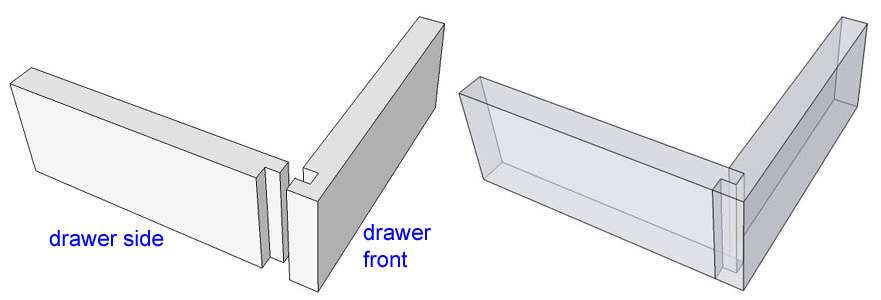
lock nut --- A nut with some sort of mechanism that prevents vibration from loosening it. There are two basic forms, both shown in the composite pic below. The first is a captive-washer nut, which simply has a lock washer (generally an external tooth type) that is integrated with, and not removable from, the nut. The washer may or may not spin freely; for the fixed-position washer, the tightening has to be done from the bolt end, whereas if the washer spins freely, the nut OR the bolt may be tightened. When the washer spins freely, this type is known as a "K-lock" nut or a "Kep" nut The second is the nylon-insert type which has a nylon center instead of a metal one; the nylon compresses somewhat when force is applied during the tightening of the bolt, thus creating a spring-like force against the nut. Another mechanism that keeps nuts from vibrating loose is the castle nut which is not normally called a "lock nut", just a castle nut.Examples:
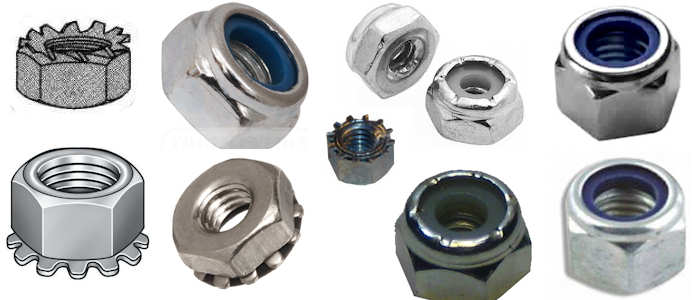
lock stile --- The doorframe stile to which the door lock is affixed.
lock washer --- A washer that in some way causes the screw or bolt head to lock in place so that it will not be affected by vibrations. Machinery parts, for example, often vibrate severely and a bolt can just back right out of a hole because of the vibration so some kind of pressure is needed to keep the bolt from moving in the first place. Lock washers are rarely needed in wood because wood won't generally vibrate a screw out of its hole the way threaded metal will. The primary types of lock washer are:
lodged tree --- synonymous with hung tree
log --- A segment of the trunk of a tree when removed from the stump and stripped of branches. There is no implication as to whether or not it has been debarked.
log defects --- Imperfections that affect the value of a log. Defects may include red knots, black knots, rot, burned area, crook, sweep, and doglegs.
log roller --- same as footed cant hook
logger --- An individual who harvests timber for a living; may be an individual operator or a member of a company team of loggers.
logging --- The process of cutting trees and moving the logs to a sawmill.
log run lumber --- synonymous with flitch cut
long bent --- Describes tools that have a gentle curve going the length of the steel shank, for shallow recesses. Compare/contrast to short bent.
long grain --- A term used to describe a situation where the general direction of wood fibers lies along the length of a piece of wood. Compare/contrast to short grain. Example:
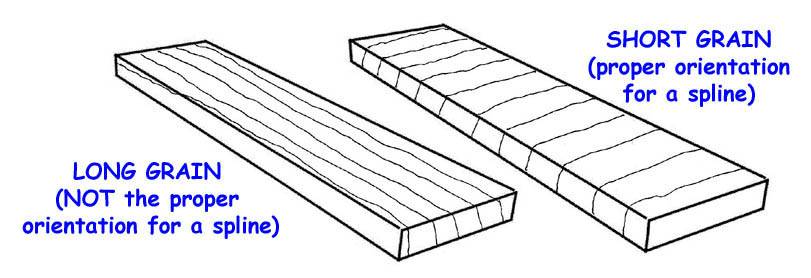
longitudinal --- As regards woodworking, the term means running in the direction of the long axis of a body or structure; following the greatest length of an area or object. Thus, the longitudinal axis of a tree is a line running up through the center of the tree's length, and a longitudinal beam is a beam running along the length of a structure, not across its width. The longitudinal direction in a log is necessarily parallel to the grain but the longitudinal direction of a small board COULD be perpendicular to the grain if the board were cut across the grain of a log such that the grain ran perpendicular to the length (as for example in a spline). Compare/contrast to radial and tangential.
longitudinal shrinkage - Reduction in size of a piece of lumber that occurs parallel to the axis of the tree, and is caused by drying the wood out either through air drying or kiln drying. Green (unseasoned lumber has so much moisture in it that it contracts in size when dried, and this contraction occurs differently in the three planes of the wood (radial, tangential, and longitudinal). The shrinkage is expressed as a percentage of the dimension of the wood when green. So, for example, if a plank were 12 feet long when green and 11 feet 11 inches long coming out of the kiln, it would have a shrinkage of .7%, and because of the direction, this would be longitudinal shrinkage. Compare/contrast to radial and tangential shrinkage. Longitudinal shrinkage is generally negligible, the other two are not.
Longworth chuck --- A very simple, clever design for a homemade jig that acts as a bowl chuck for turning the bottom of bowls which have already had all of their upper surfaces (inside and out) turned. It consists of a pair of plywood (or other material) circles with crossing arcs in which you put bolts with rubber covers to protect the wood. There are instructions on the Internet for making them. Examples:

loose --- (1) see floating
loose --- (2) As regards veneer, there is a complex interaction in the cutting process that results in veneer sheets having a "tight" side and a "loose" side. The tight side is also called the "closed face" and the "closed side" and the loose side is also called the "open face" and the "open side". What happens is that as the thin sheets of wood are sliced off of the log, the slicer cuts into the wood cells and loosens them and as the sheet curls away from the slicer the loosening is increased on the side of the sheet next to the slicer, resulting in a condition called lathe check. The part still on the log has its cells loosened somewhat less during that pass of the slicer because it isn't being curled, and then when its turn comes to be sliced off, that surface becomes the curl-compressed side away from the slicer and its cells are compressed up against a holding bar. So the "underside" of each sheet (the side next to the slicer as it is sliced off the log) is "loose" and the other side is "tight".
The problem this creates is in "matching" veneer sheets. See veneer matching. The tight and loose sides reflect light differently (sometimes VERY differently) and absorb finishes differently, thus giving a sometimes very considerable difference in the appearance of two sheets that would otherwise look identical (except for the grain direction, depending on the matching technique). Some matching techniques (e.g. slip matching) don't have this problem because they allow all tight or all loose sides to face up, but one of the favorite matching techniques, book matching, does have this problem, as do some others.
It is very simple to tell which side of a veneer sheet is tight and which is loose. Just flex the sheet (across the grain, not along the grain) and you'll see that it bends more easily in one direction than the other. The side that is concave when it is in the easily flexed position is the tight side. Where possible, the loose side should always be placed down when gluing veneer onto a substrate for two reasons. First, it will absorb the glue better than the tight side, so should be down, and second, the tight side will present a more smooth surface, and so should be up.
loose grained --- Has widely spaced annual growth rings. Compare/contrast to tight grained. Example:

loose knot --- A knot that is not held firmly in place by growth (intergrown knot) or position and that cannot be relied upon to remain in place when a board is put into service. See knot for further discussion. The opposite of tight. Encased knots are usually loose knots but if jambed tightly in place, they may not be. Such knots are often rated the same as knotholes since they are usually destined to become knotholes.
loose mortise and tenon --- This is a variant on the standard mortise and tenon joint, the difference being that the tenon is not part of one of the joining pieces but rather is loose, like a spline, so that the joint actually has two mortises and a loose (also called "floating") tenon. Example:

loose mortise and tenon with angled shoulder --- see angled shoulder mortise and tenon
loose pin hinge --- The "normal" type of (hinge) pin; the pin is not permanently affixed to any of the (hinge) knuckles but rather floats freely and can be removed so that the knuckles can be separated. The most common type of hinge to use this is the standard residential door hinge. Compare/contrast to fast pin hinge
loose tenon --- see loose mortise and tenon
loose wedge --- When a wedged joint such as the tusked mortise and tenon joint has the wedge left unglued so as to make the joint a knockdown joint then the wedge is said to be loose (because, hey ... it IS loose. Sometimes these terms just make so much sense it's scary).
loper --- A support bar that pulls or rotates out under a fall front or a fall flap.
louver --- A slatted door, window, or opening. Usually the slats are horizontal but sometimes vertical, and in any case are intended to allow passage of air while blocking rain and direct sunlight, and to a lesser extent, noise. Sometimes the slats will be adjustable. louvered doors are normally made with wooden slats and louvered windows are normally made with glass slats. The term is sometimes used in a broader sense of a vented or baffled opening such as a roof louver, which is made of sheet metal. A gable louver is a bit like a louvered window with the significant exceptions that it is made of wood and the slats are not adjustable. For examples, see the various kinds of louvers referenced in this paragraph.
louvered door --- A door made primarily of slats, usually mounted at an angle. Very common for closet doors and doors to recessed laundry areas because they allow for some air flow. Examples:
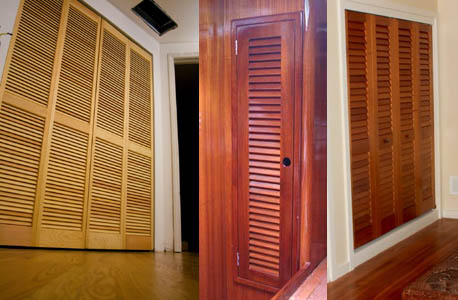
louvered window --- A window made up primarily of slats, normally of glass ('cause it's really hard to see through wood) and usually adjustable, to allow varying degrees of air flow while blocking rain and snow. Examples:
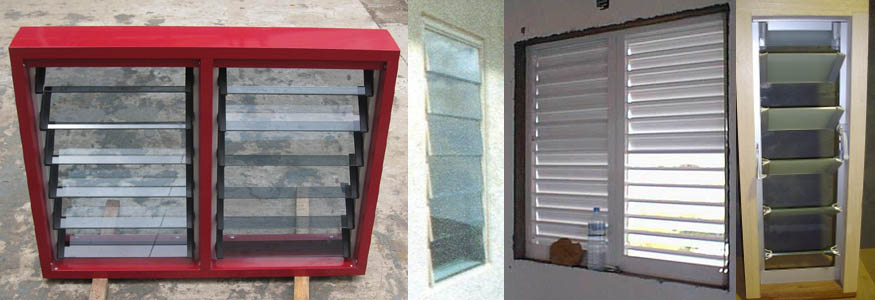
low gloss --- see finish rating
low relief carving --- see relief carving
low slope --- Roof slopes up to 33% are considered low sloped roofs. Special installation practices are usually required on steeper pitched roofs. Compare/contrast to steep slope.
LSL --- laminated strand lumber
lumber --- Solid wood in any form from the time a tree is cut down and stripped of its bark and branches, to the point where it is ready to be used in whatever its final form is to be (construction, furniture, etc.). Some definitions of lumber state that it only applies to wood that has been reduced by cutting from a tree (into boards, planks, slabs, etc.) and while that is the more common use, it really also includes logs that have been stripped of bark and limbs but not yet processed. Think of it this way: the railroad cars that carry such logs are called log cars but they are also called lumber cars, and likewise, flatbed trucks that carry them are called log trucks but they are also called lumber trucks. Also, in North American, "lumber" is a synonym for "timber" which is a term that is more widely recognized as including logs. In North America, the term "timber" is used pretty much synonymously with lumber, although timber (which, in strictest terms refers to standing trees) carries a connotation of largeness that lumber does not. To be unambiguously correct, one should speak of standing trees as timber and cut, stripped, trees as lumber, but that's not always the way "timber" is used. Besides, that leaves open what it is you should call a tree that has been cut down but not yet stripped. "Felled timber" perhaps? We English-speakers get a little vague around the edges sometimes.
Traditionally produced from very large diameter logs, lumber is now often made from logs as small as 8 to 12 inches in diameter. A variety of equipment is used to produce lumber. Newer mills that process softwood logs combine scanners, computers to calculate optimum sawing sequences, and high speed, thin-kerf saws designed to obtain maximum lumber yield. The newest "lumber" products are not lumber at all in the traditional sense, but composite materials created from veneers, thin flakes, wood chips, or other materials such as plastic. Such products have more uniform strength properties than solid-sawn wood and can be made to large sizes even when using small trees as raw material. Lumber, when cut down to size for use is generally measured, bought, and sold based on nominal, rather than actual, sizes. Measurements are affected by moisture content and, in the case of hardwoods, by whether boards are surfaced or unsurfaced. See lumber sizes for some relative-sized "type" of lumber. See also lumber conditions.
lumber conditions --- There are a number of different process that lumber can go through and there are different conditions of lumber. Some of the terms used to describe these things are:
lumber-core plywood --- plywood where thin veneer sheets are glued to a core of narrow boards. Lumber-core plywood differs from regular plywood in that regular plywood (veneer core plywood) is made up of successive layers of alternating grain veneer. See the pic of lumber-core plywood shown with the term plywood. The strips of wood in lumber-core plywood are placed with alternating annual growth rings orientation so as to minimize warp. Contrast to veneer core plywood and particleboard-core plywood.
lumber defect --- see defect
lumber sizes --- The following "definitions" are composites from numerous sources and I do NOT deem them to be particularly reliable. That is, I don't know that they are in any way incorrect, but neither do I know that they are correct and I present them for relative values only:
- batten --- generally thin and narrow
- baulk --- (1) square cross section, (2) about the same as a 2x4
- board --- at least several inches wide, at least 3/4" thick, and long relative to width
- cant --- a long square of wood that is basically a tree's width but with flat sections cut off of four sides; could be as short as 4' but is usually 8' or longer
- deal --- 2 and 4 inches thick and 9 and 11 inches wide, and usually means softwood
- flitch --- at least 4" thick and 6" wide
- heavy scantling --- same as flitch
- plank --- a thick board
- scantling --- construction lumber with a modest cross section
- strip --- no more that 3/4" thick and no more than 3" wide
- thinwood --- no more than 1/2" thick but generally thinner
luster --- shine / polish / sheen / etc. --- the way in which something reflects light. For raw (but surfaced) wood, luster will vary greatly depending mostly on the species of wood, but also partly on the angle at which the light strikes the surface and the type of cells exposed on the surface. In some species, quartersawn surfaces have a higher luster than flat cut surfaces because of the ray flakes. A wooden object with a few coats of a dull finishing agent would have a low luster and an object with a dozen or more coats of lacquer would have a high luster.
LVL --- Laminated Veneer Lumber
LVLP --- Low Volume Low Pressure (a type of spray-gun mechanism). See also HVLP.
lyctid borer --- A wood borer, sometimes known as the powder post beetle, that attacks some hardwoods.
lyctid susceptibility --- The characteristic of a wood species that is The extent to which lyctid borers are likely to be successful in attacking that wood.
for images of wood itself, go here: wood id site
A
B
C
DE
F
GH
IJK
L
M
NO
P
QR
S
T
UVWXYZ
To see general comments about this glossary and for the email address, click here: GLOSSARY





























